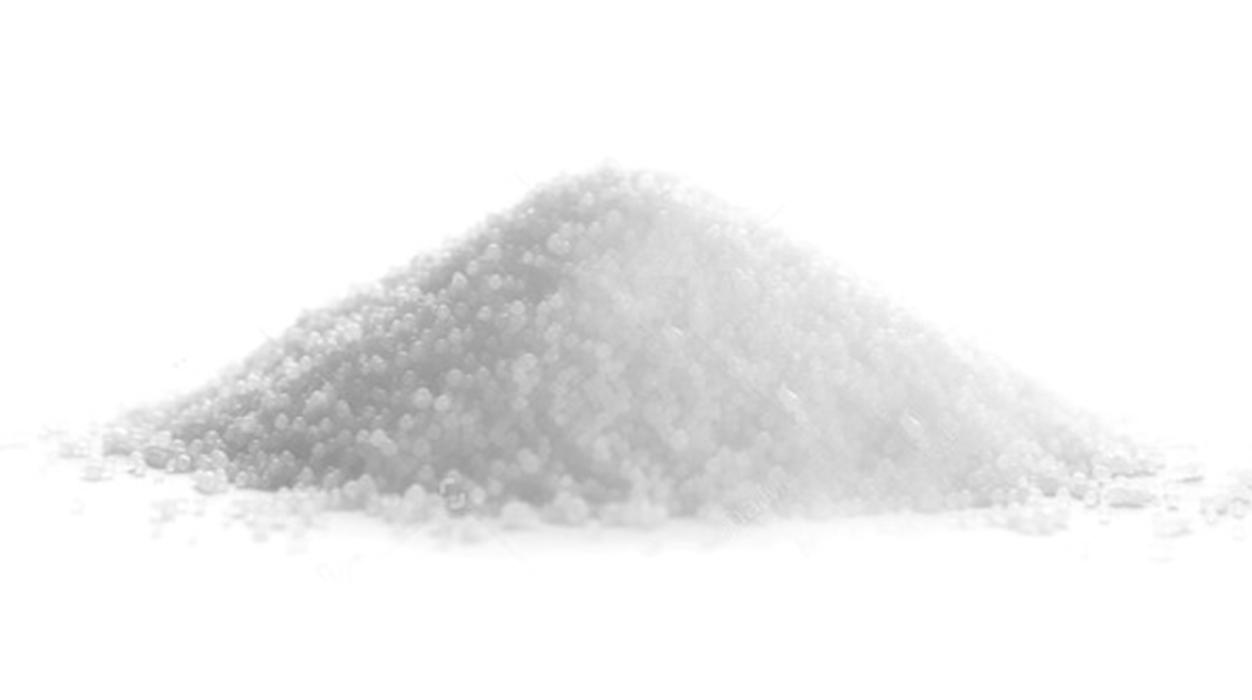Digital Twin,
as a Service!
Unlock up to 25% more capacity from your existing Prilling Tower.
Smarter prilling. Same process. Greater control.
Book feasibility call here!
Prilling towers have been installed worldwide. Many are over dimensioned by today’s standards. With the right setpoints tuned to the actual ambient and process conditions, a substantial increase in production capacity and quality is achievable.
Why this matters
Small shifts in weather conditions, melt properties, or equipment condition can push performance off target, resulting in more off-spec prills, increased dust levels, and more cleaning stops. Trial-and-error approach can result in an average setpoint recommendation, for average production results, but it won’t reveal the ideal operating window on a daily basis.

A pathway to better performance
Pre-scan (Client Declared Data)
A rapid assessment based on the client’s unique tower dimensions, operating data, and melt properties. These data sets will be used to estimate:
- Potential capacity envelope (often up to +25%)
- Expected Particle Size Distribution (PSD) window
- Sensitivity to ambient and process variability
- Scaling on the tower wall and tower bottom
- Operational window of the Priller
When to use: You want to see the upside fast, to decide if the journey is worth it.
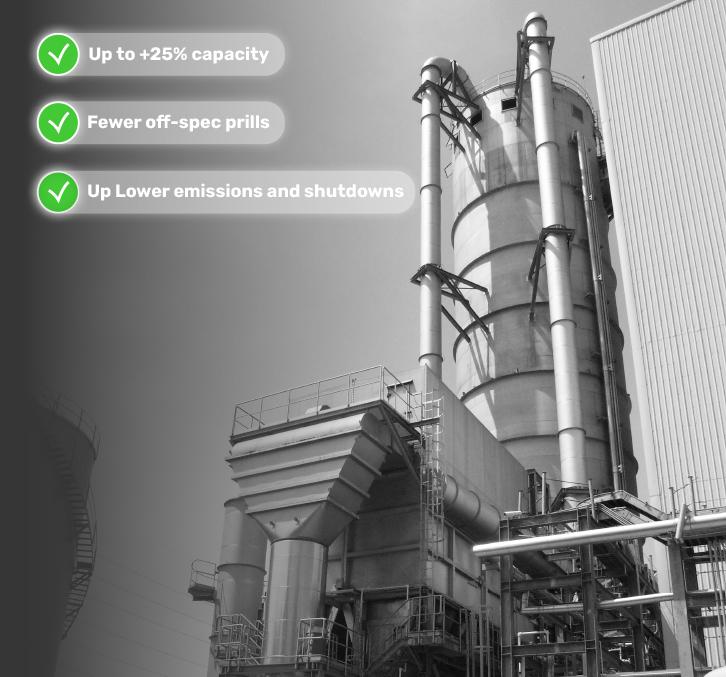
Digital Twin as a Service (DTaaS)
A bespoke, validated model of your tower that replicates every minute of operation and lets you test any change without risk.
What we validate:
- Exact dimensions of the tower and sensor positions (on-site survey)
- Physical properties of the melt (Kreber laboratory testing)
- Process model calibration against real plant data (on-site)
What this unlocks:
- Minute-by-minute replay of production runs
- Setpoint recommendations for capacity, PSD, dust reduction, scaling avoidance
- What-if scenarios for product specs, ambient shifts, and operating modes
- Virtual trials of OEM upgrades (IR cameras, bucket clogging detection, flow monitoring - PrillTech) before you invest
When to use: You want a validated, ongoing performance engine. Not a one-off study.
Prefer classic training? We offer on-site operator training & support. However, where operator skills decay and staff rotations create variability, DTaaS will reinforce best practices continuously with data, not with operator specific experience.
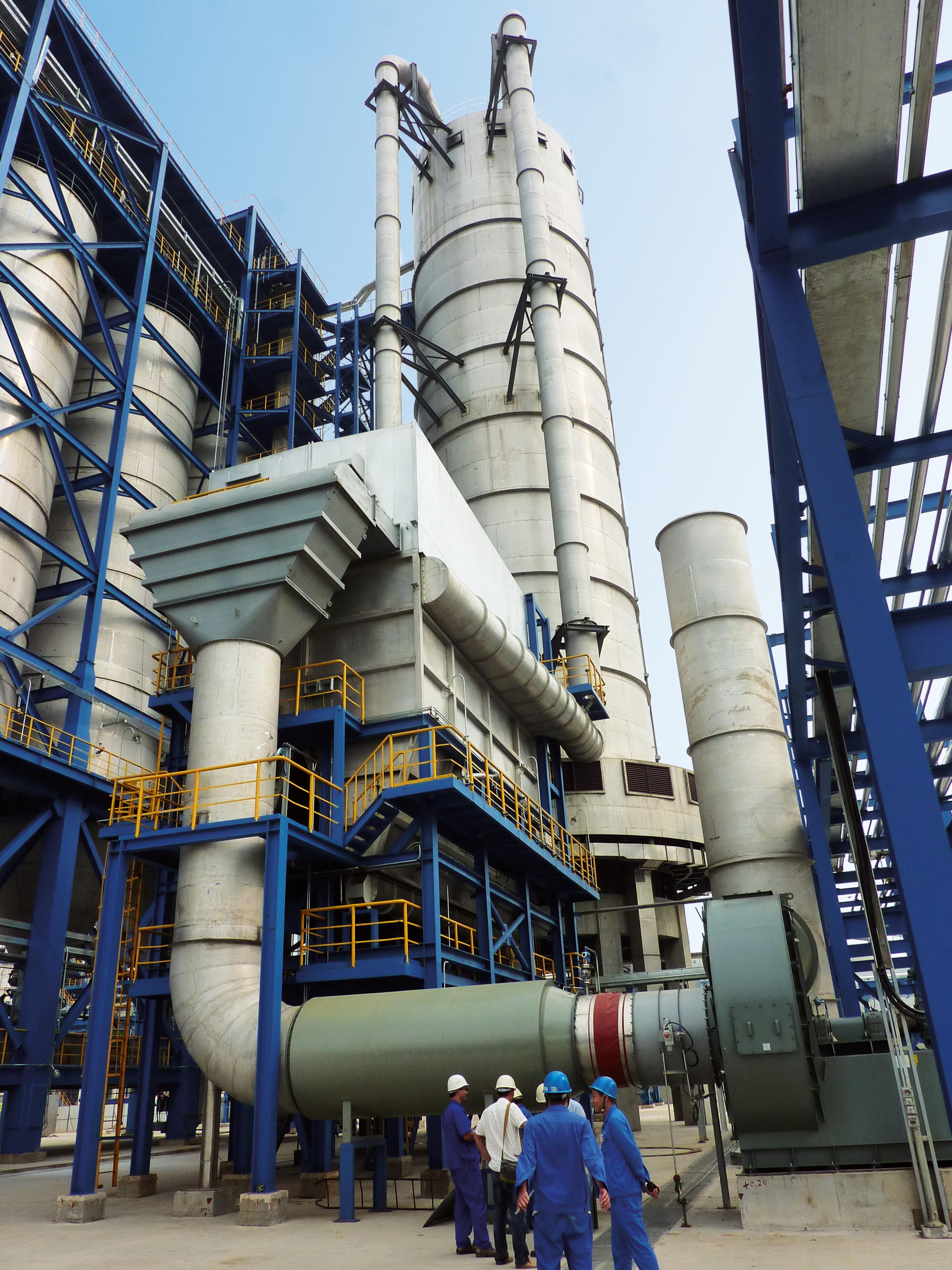
How our Digital Twin Service works
Feasibility (remote, from Pre-scan)
We model the expected current performance from the client based data and project your capacity/PSD potential.
On-site survey & lab validation
We capture the real-life tower geometry and sensor layout, calibrate the process model data, and validate melt and prill properties in our lab.
Build & validate your Digital Twin
A plant-specific twin mirrors your tower and baseline production. We prove it by computing a production run and match outcomes.
Operate as a service
Kreber hosts the twin and provides simulations, with clear, actionable guidance. You get the insights; we handle the modeling.
What you receive
For whom
Stable plants starting with DTWhat's included
- Hosting
- Annual model update
- 2 Scenarios / yr
- Monthly email summary
SLA
Response in 2 business daysFor whom
Most plantsWhat's included
- Hosting
- Semi-annual updates
- Monthly bottleneck report
- 5 Scenarios / yr
- 2 review calls
SLA
Next-business-dayFor whom
High-volume / variable sitesWhat's included
- Hosting
- Proactive monitoring
- Monthly bottleneck report + OEM roadmap
- 10+ Scenarios / yr
- Quarterly reviews
- Priority support
SLA
Same-day (business hours)For whom
Groups / corporateWhat's included
- Centralized support across towers
- Shared credits
- Corporate reporting
SLA
Agreed programAdd-ons: Operator dashboard & training, on-site workshops, OEM sensor intergration (IR cameras, bucket-clogging detection, flow monitoring), Pilot Plant tests and Emergency technical support on site upon request.
OEM innovation, de-risked
- Infrared cameras temperature & wetting control
- Prilling bucket clogging detection flow stability
- Flow monitoring & control --> tighter PSD and capacity
We provide impact forecasts and a prioritized upgrade roadmap inside your monthly report.
From DTaaS to PrillTech (the next step)
Once your team is comfortable with simulation-guided changes, PrillTech can intervene in real time—closing the loop faster than DTaaS. The prilling production will increase to new and improved levels. DTaaS proves the gains and builds trust; PrillTech scales them minute-to-minute.
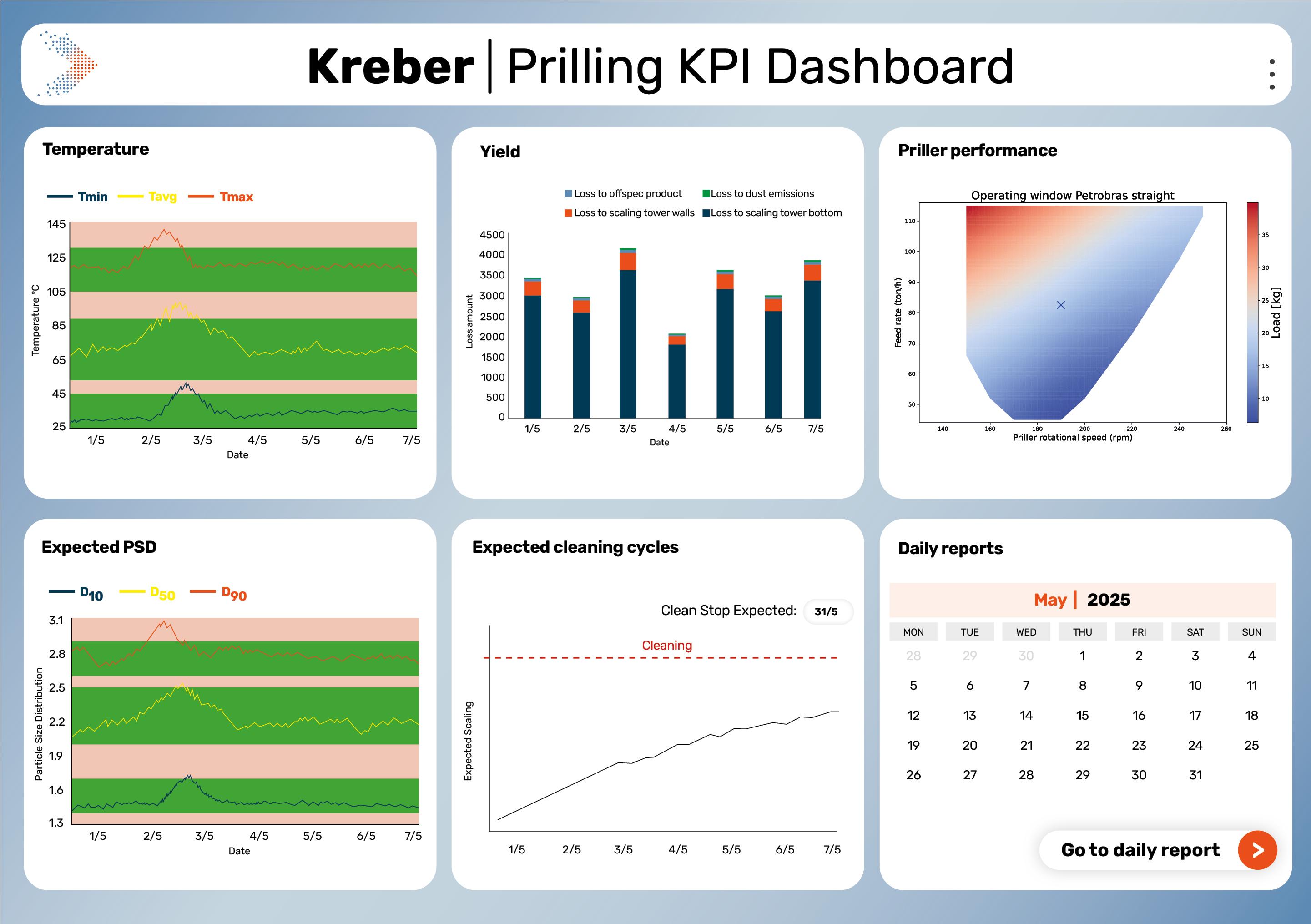
FAQ
Many towers are structurally capable of more. The achievable gain is site-specific and depends on melt properties, ambient conditions, internals, and current constraints. The Pre-scan shows the potential with the existing process; DTaaS validates and operationalizes it.
No. Modeling is offline. On-site measurements are planned to avoid interference with the typical production schedule.
No. Kreber hosts your twin; you receive the reports and recommendations.

PrillTech
Real-time optimization for your Prilling Tower
Unlock hidden capacity, stabilize PSD, and cut dust without overhauling your plant. Talk to an expert and see how it works!
What is PrillTech?
PrillTech is closed-loop setpoint optimization for Prilling Towers. It continuously reads your plant sensors, runs model-backed checks, and recommends or applies optimized setpoints to hold capacity, PSD, and dust within target windows. No major installation or downtime required.
How It Works
1. Sense: IR temperature & wetting, bucket-clog detection, flow, tower conditions (OEM integrations available).
2. Simulate: The Kreber Digital Twin predicts outcomes under current/near-future conditions.
3. Optimize: PrillTech computes best-fit setpoints for capacity, PSD, dust/fouling risk.
4. Act: Recommendations (or supervised automatic adjustments) feed your control room with audit trail and guardrails.
Already using Digital Twin as a Service (DTaas)? PrillTech is the next step. Moving from scenario advice to continuous, real-time optimization.

Operator prompts or supervised auto-tuning
Top constraints, root causes, actions
Modeled impact of OEM add-ons before you buy
Response times and escalation paths that match your site
PrillTech layers on top of your existing DCS/SCADA to sense, simulate, and adjust setpoints in real time. Turning variability into stable, higher-throughput operation. Built on Kreber’s Digital Twin, upgraded for live intervention.
• Since 1960: hundreds of towers designed
• In-house lab & pilot
• OEM sensor integrations (IR cameras, clogging
detection, flow monitoring)

PrillTech Outcomes
Higher capacity from the same tower (often significant headroom)
Tighter PSD; more on-spec prills
Lower dust & fewer cleaning stops
Reduced OPEX via fewer interventions and stable operation
Why PrillTech vs. traditional training?
Operator training helps but skills fade and shifts vary. PrillTech reinforces best practice every minute, with data-driven guidance that doesn’t forget at 3 a.m.
Integration & rollout
• Works with existing DCS/SCADA
• Minimal installation, planned to avoid downtime
• Optional OEM sensors (IR, clogging detection, flow) for richer signals
Start with a Pre-Scan, upgrade to Digital Twin as a Service and go live with PrillTech!
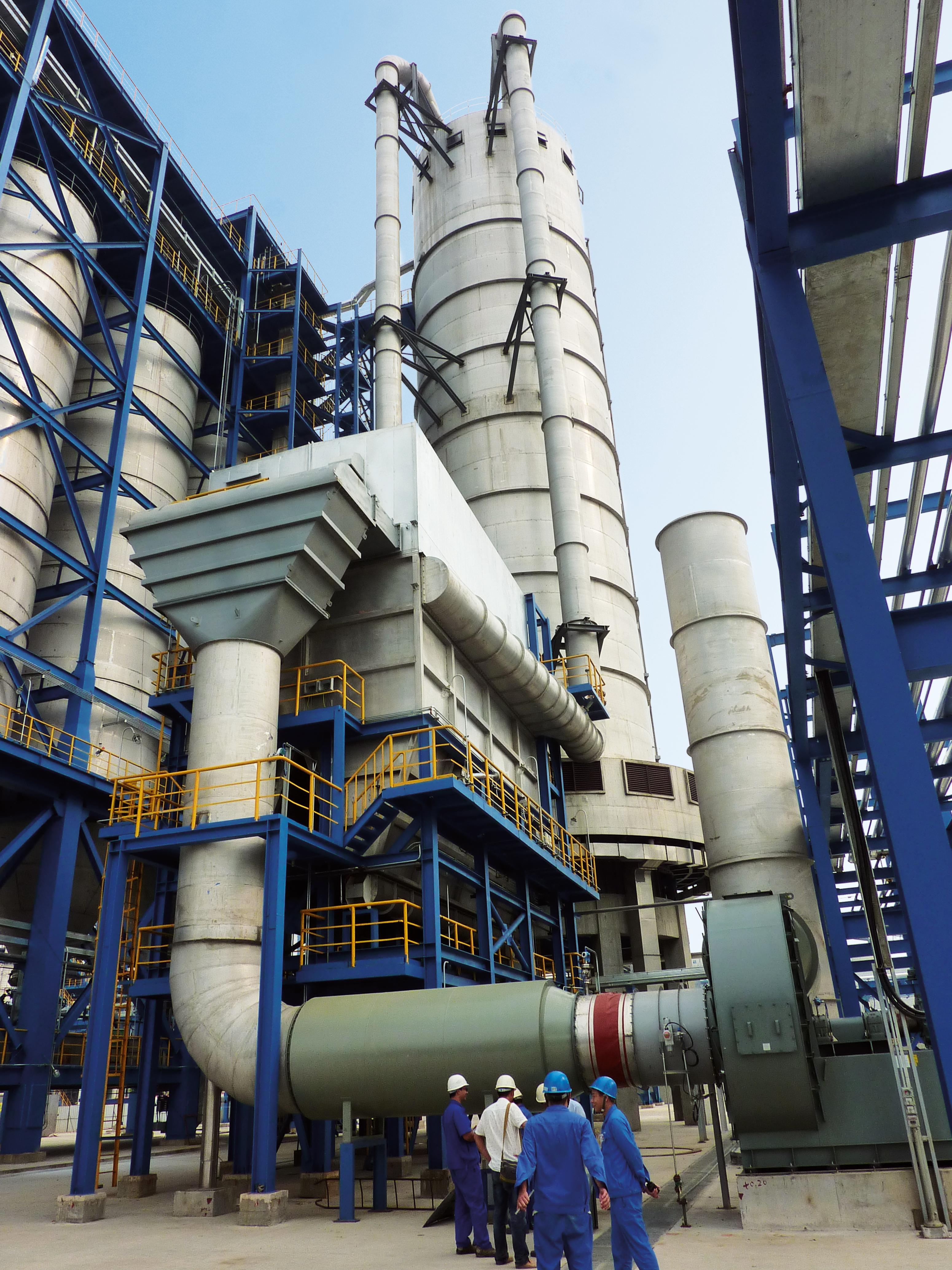
Ready to stabilize and scale your Prilling output?
Start with a Pre-Scan
Contact us today to start your journey
The first fertilizer Prilling machine we built in the 1960s is still in operation today and continues to deliver a positive cash flow for our client. The proof of this track record is our ever-growing prilling reference list.
Types of Prilling machines
Kreber Prilling Machines are characterized by high reliability, low operational expenses, and ease of operation.
Depending on the type of product, the required quantity, and the prilling tower conditions, we offer one of two types of prilling machines: the Kreber Static Prilling System or the Kreber Rotary Prilling System.
Prills for bulk properties offer significant advantages:
- Excellent 'free-flowing' properties
- Low tendency to stick and agglomerate
- Distinguished for air lifting
- Highly resistant to abrasion and damage
- Minimal dust formation
- Excellent for starage in silo installations
- Precise dosage
- No additives needed; pure materials
Static Prilling
We offer the Kreber Static Prilling System for the conventional method of Prilling. This type of system can contain one or more Prilling heads and is very suitable for capacities ranging from 5 to 500 metric tons/day.

Rotary Prilling
The Kreber Rotary Prilling System has two rotary Prilling buckets. This allows for quick changeover of Prilling buckets, this ensuring continuity of production. This type of system is suitable for capacities ranging from 75 to 5000 metric tons/day and comes in a number of standard models to which various applications can be flexibly added.
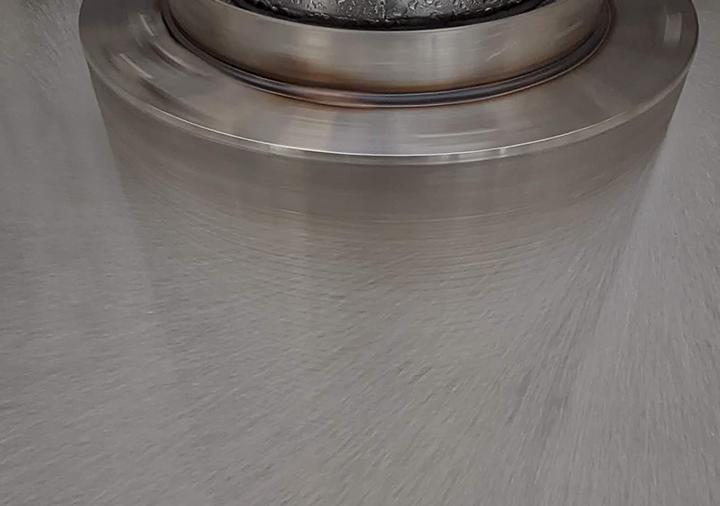
Vibro Prilling
Thanks to our innovative facilities, the R&D team is able to take Prilling technology and customer solutions to the next level. One of our major developments is ‘Vibro Prilling’. Applying vibration to the melt results in more uniform Prills with a narrowly defined prill size distribution. This principle can be applied to both static Prilling and rotary Prilling.
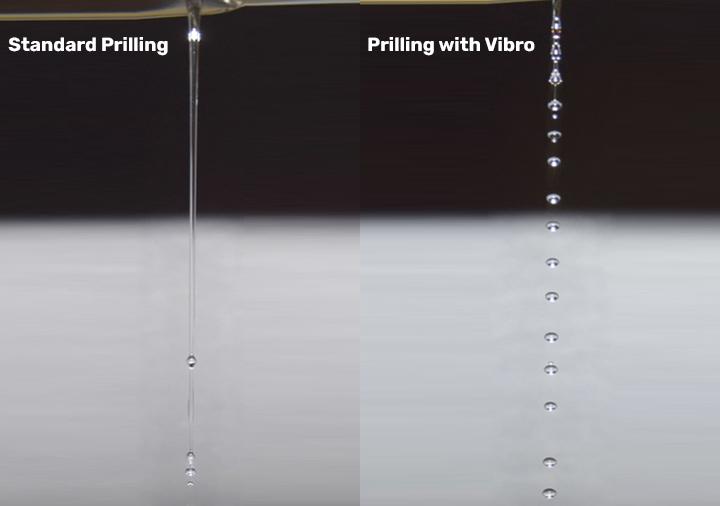
Pilot-Scale Test MicroPrilling
Testing 'prillability' on a larger scale.
At Kreber, we have two testing facilities available to determine whether MicroPrilling is feasible for a product: the Kreber Laboratory Facility and the Kreber Pilot Facility.
Kreber Pilot Facility
Next to Lab Scale Testing, we use Pilot Facility Testing to investigate feasibility in the Industrial stages. At the Kreber Pilot Facility, we study ‘prillability’ on a larger scale. Both facilities are operated at an industrial location, which makes it possible to safely test a wide variety of materials.
It allows us to pursue several goals, such as generating an industrially representative sample in batches, mapping dust formation rates, and gaining new insights that enable the optimization of industrial prilling tower design.
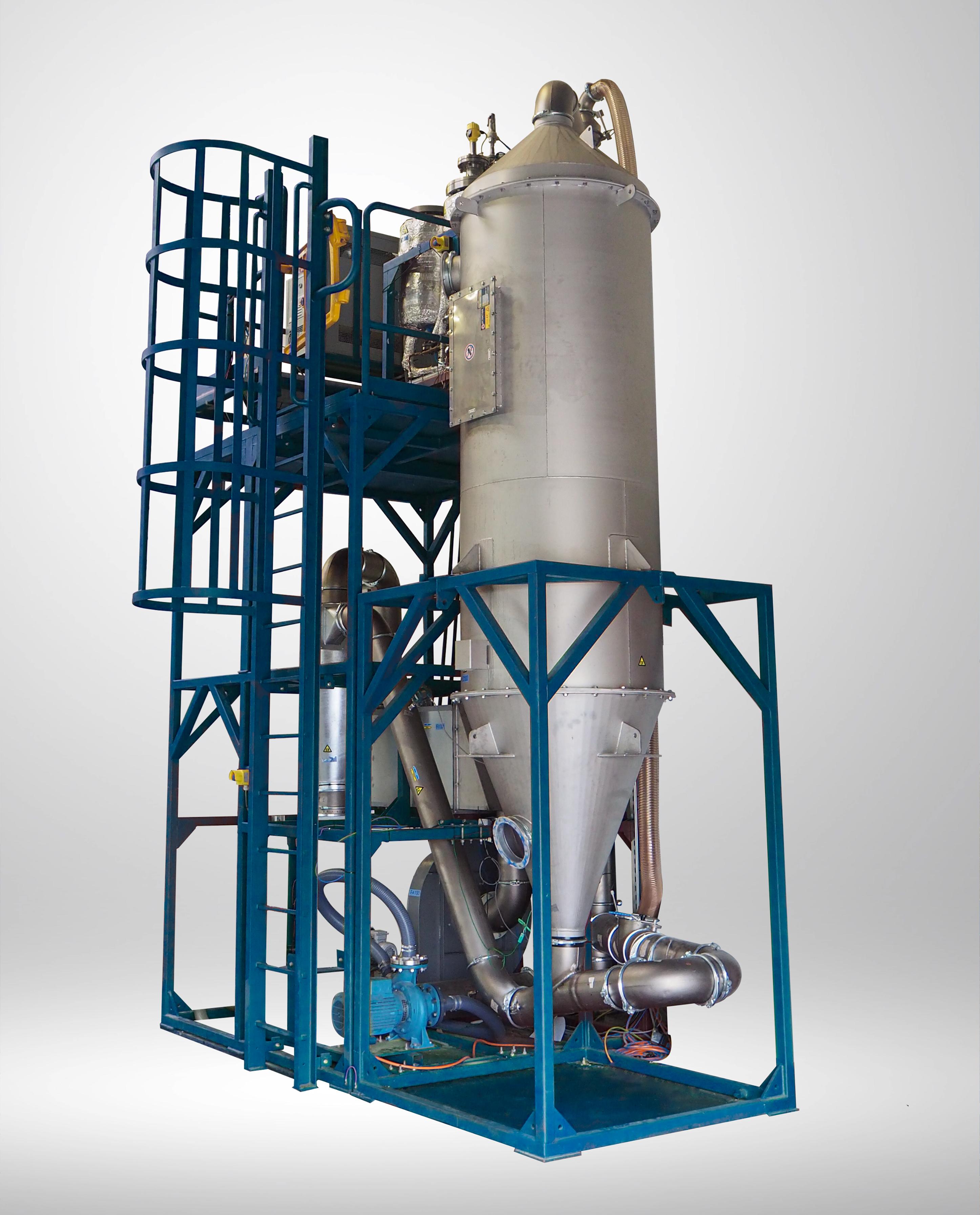
The Pilot-Scale Test consists of:
We look forward to providing you with advice and a solution tailored to your needs.
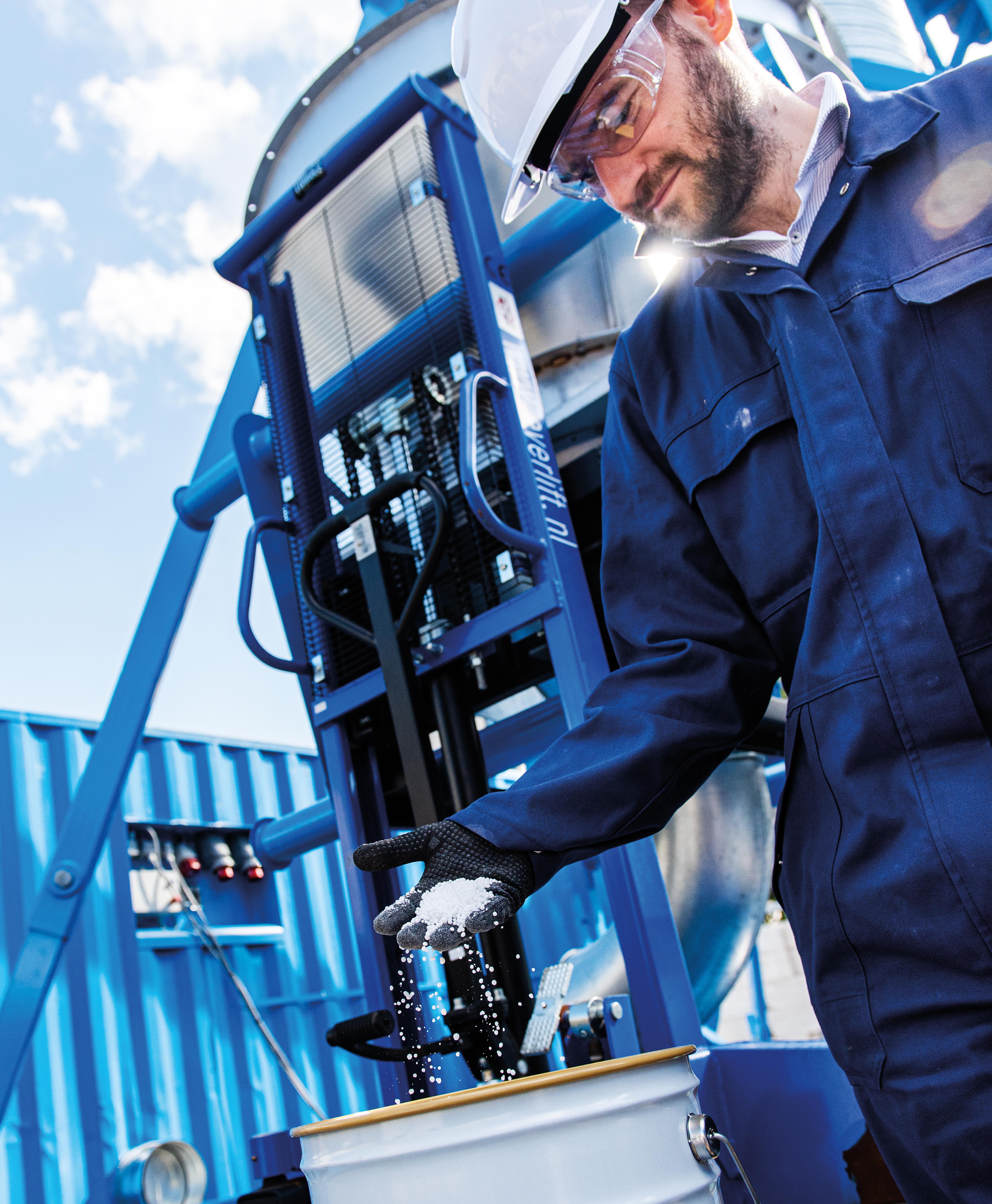
Pilot-Scale Test Prilling
Testing 'prillability' on a larger scale.
At Kreber, we have two testing facilities available to determine whether prilling is feasible for a product: the Kreber Laboratory Facility and the Kreber Pilot Facility.
Kreber Pilot Facility
Next to Lab Scale Testing, we use Pilot Facility Testing to investigate feasibility in the Industrial stages. At the Kreber Pilot Facility, we study ‘prillability’ on a larger scale. Both facilities are operated at an industrial location, which makes it possible to safely test a wide variety of materials.
The Kreber Pilot Facility is a modular prilling tower which is 24 meters in height. It allows us to pursue several goals, such as generating an industrially representative sample in batches, mapping dust formation rates, and gaining new insights that enable the optimization of industrial prilling tower design.
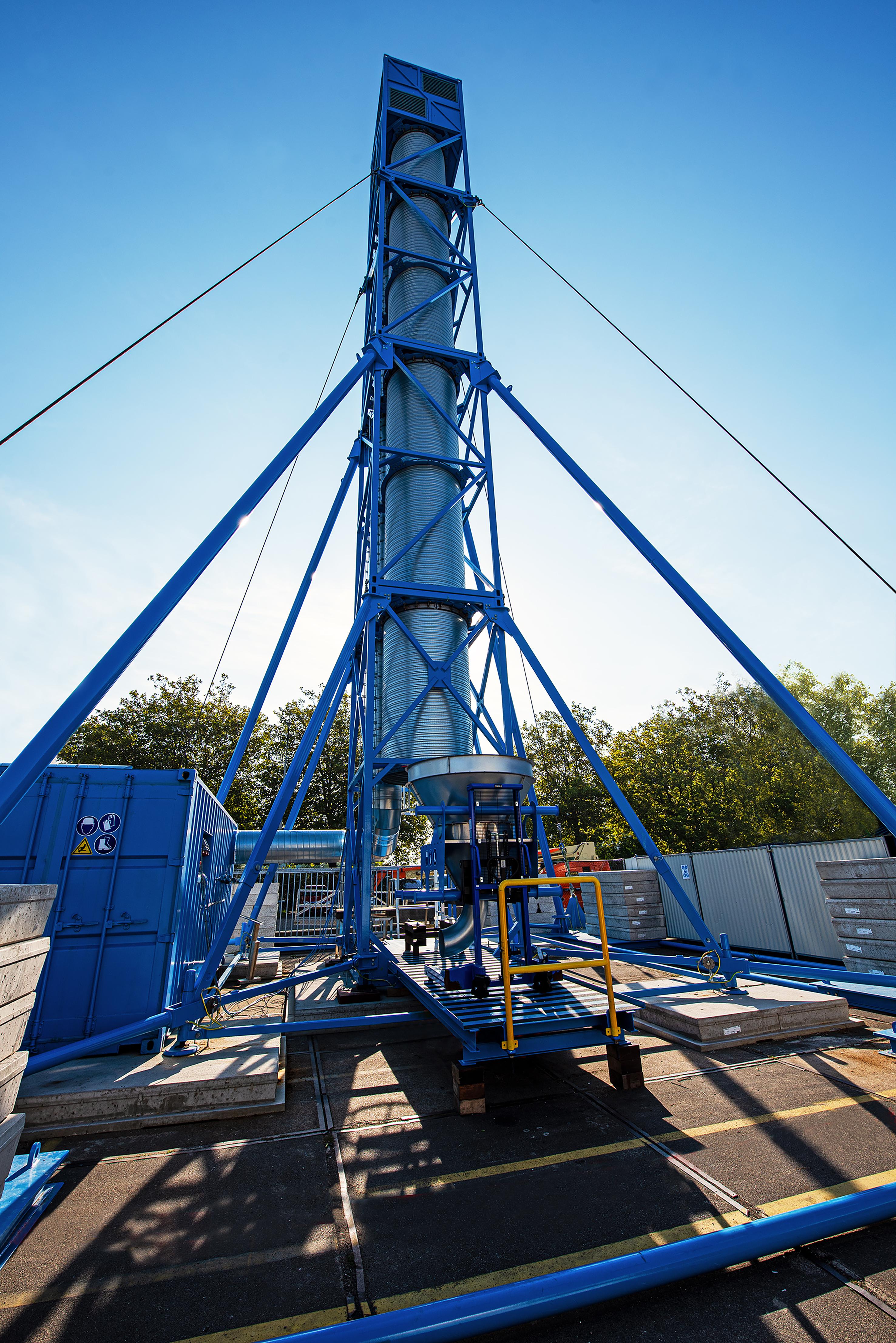
The Pilot-Scale Test consists of:
We look forward to providing you with advice and a solution tailored to your needs.

MicroPrilling
Advanced Particle Technology for Modern Manufacturing
What is MicroPrilling?
MicroPrilling, also known as Spray Congealing, is a highly efficient process for producing solid powders from melts. It transforms liquid feed into uniform, spherical solid particles using a combination of precision atomization and rapid cooling.
How It Works
Atomization: The melt is heated to a specific temperature and then atomized using a high-pressure nozzle system. This creates fine, consistently sized droplets.
Rapid Cooling & Solidification: These droplets are introduced into a temperature-controlled chamber, where they encounter a cold gas stream or cooling medium. The sudden temperature drop causes the droplets to rapidly solidify into uniform particles.
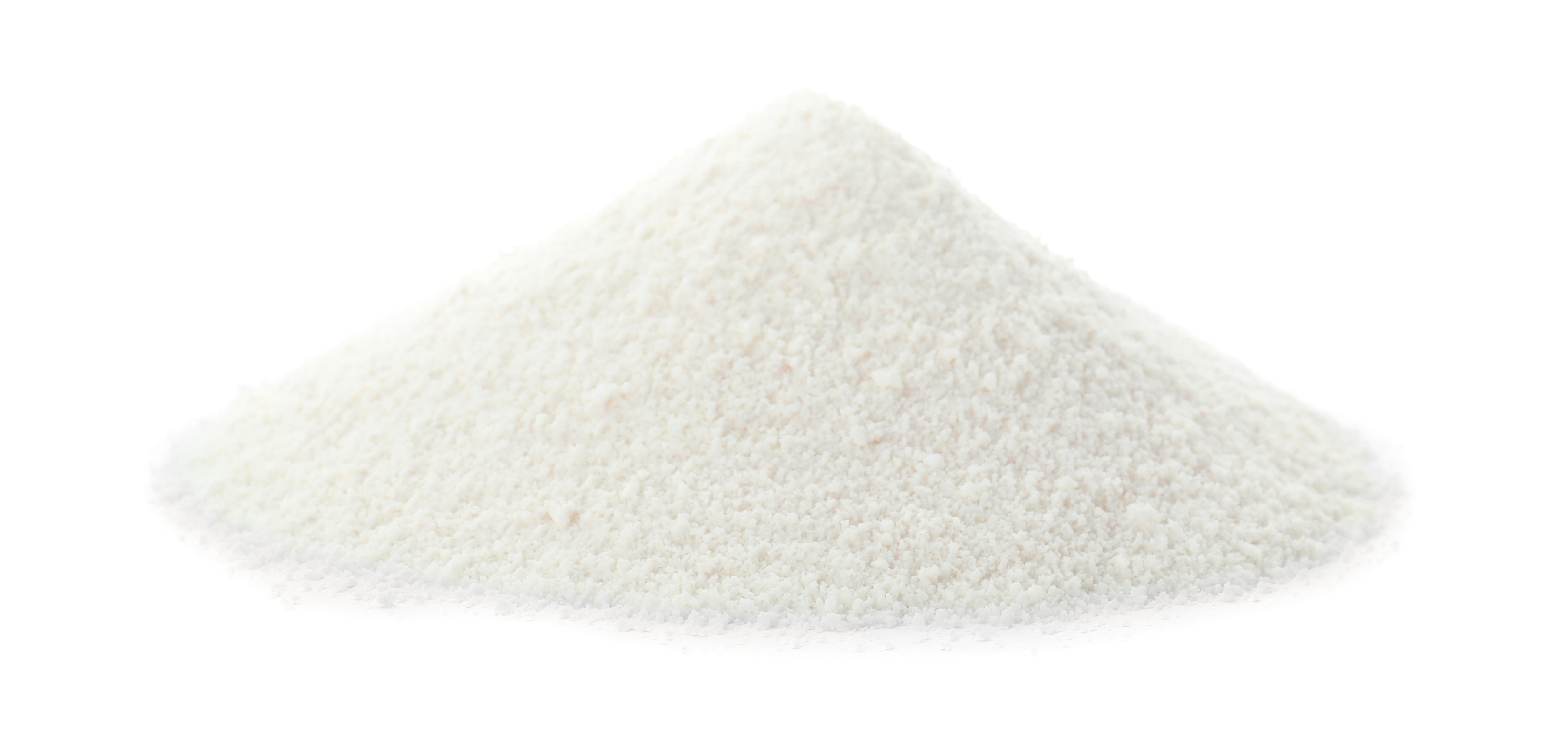
MicroPrilling enables the production of spherical particles with precise and uniform sizes. This uniformity enhances product quality and performance, making spray congealing ideal for applications where consistency is critical.
Our equipment is easy to operate, due to our well defined process operating parameters. Furthermore, the low amount of rotating and intricate parts result in a reliable process, giving the client an overall low operational and maintenance cost.
The MicroPrilling process produces highly uniform, spherical particles. This geometry enhances flowability, dosing precision, and packing density. Key advantages in applications where consistency and handling efficiency are critical.
MicroPrilling operates without the use of solvents. This eliminates the risk of residual solvents in the final product and removes the need for additional drying or purification steps, resulting in a cleaner, safer, and more sustainable process.
Thanks to a constant stream of technical innovations, such as state-of-the-art air inlet filtration and closed loop operation, emissions can be cut to virtually non existing.
Industries We Serve
MicroPrilling is used in:
Watch MicroPrilling in Action
Watch our animation to
understand how MicroPrilling
works step-by-step
Unique oppurtunity: Pilot-Scale Test
Try It With Your Own Product
Wondering if MicroPrilling is suitable for your material? Our specialized R&D team and laboratory offers you the unique opportunity to make a test batch MicroPrills of your product, tailored to your application.
Lab-Scale Feasibility Tests:
Your substance is tested on prillability
Pilot-Scale Production:
If feasible, we produce a batch to simulate industrial performance..
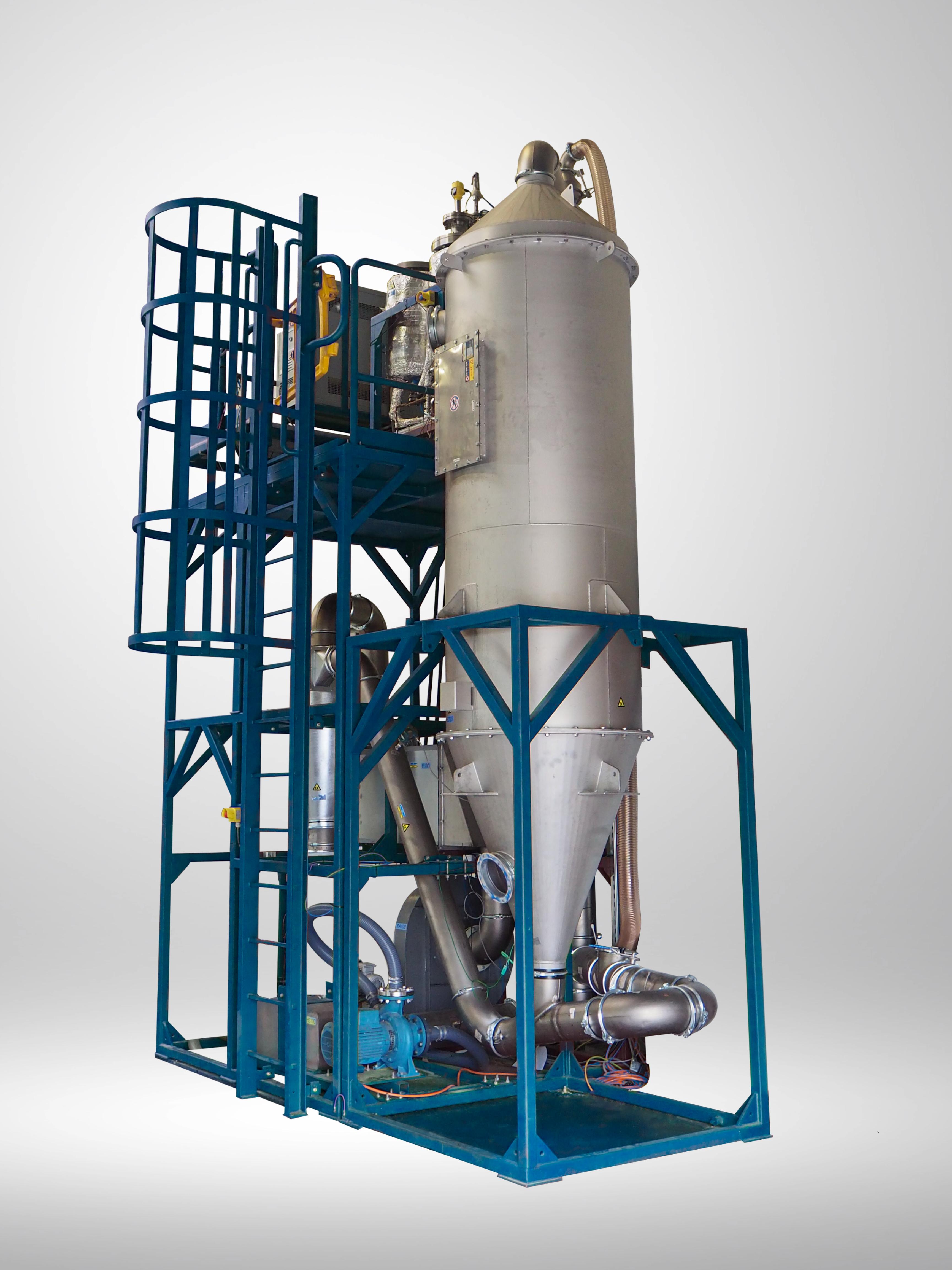
Discover. Create. Exceed.
Whether you’re developing a new process or improving an existing plant, MicroPrilling is the finishing solution trusted worldwide. Let us help you discover what’s possible.
We go from discover to create to exceed.
Discover the different stages here.
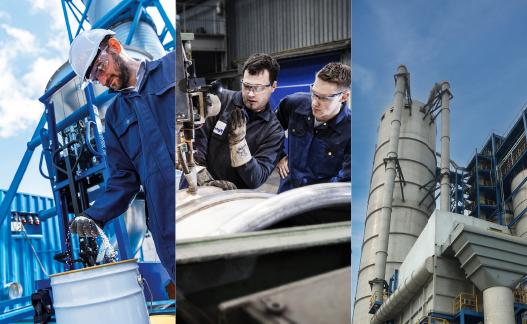
Our Services
Explore our services and let your new or existing plant benefit from the most frequently used finishing technology in the world.
We go from discover to create to exceed. Discover the different stages. In what stage can we help you?
Discover
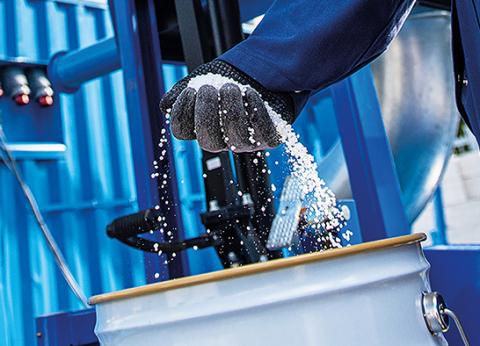
Finding the best solution for you.
Testing on lab-scale.
Prilling: Testing on a larger scale.
MicroPrilling: Testing on a larger scale.
Create
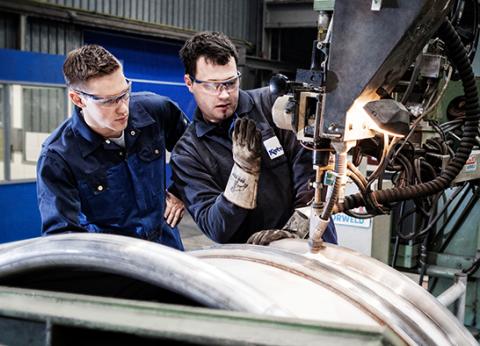
Custom engineered prilling plant design.
Fully in-house, quality guaranteed.
Ensuring maximum production reliability.
Exceed
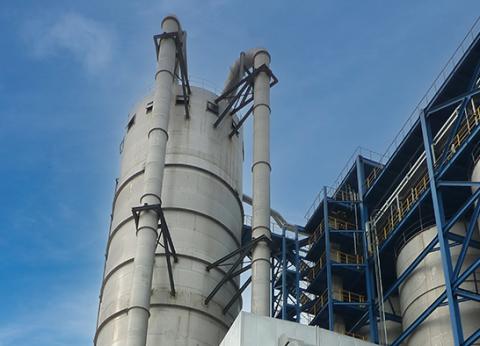
Increase capacity, optimize product quality and reduce costs.
Up to 25% more capacity with Digital Twin as a Service.
Real-time optimization for your Prilling Tower.
Preventive or exactly when you need us.
Available on demand.
Microprilling VS Spray Drying: A Comparative Analysis of Processes and Products
Particle engineering plays a pivotal role in the development and manufacturing of a vast array of products across diverse industries. The ability to precisely control the physical and chemical properties of particulate materials is crucial for optimizing performance, stability, and processability of products. Among the various particle engineering techniques, spray congealing (often referred to as microprilling, spray cooling, or spray chilling) and spray drying stand out as prominent methods for transforming liquid feedstocks into solid particulate forms
These techniques are increasingly important in sectors such as pharmaceuticals, where they are utilized for controlled release formulations and bioavailability enhancement; food science, for encapsulation and powder production; and chemical industries, for the creation of specialty chemicals.
This article aims to provide a comprehensive comparative analysis of the fundamental principles, detailed processes, equipment requirements, resulting product characteristics, and inherent advantages and disadvantages associated with spray congealing (microprilling) and spray drying.
Microprilling
Microprilling, also known as spray congealing, spray cooling or spray chilling, is a solvent-free process that transforms a molten substance into well-defined solid particles by atomizing it into a cooling chamber where rapid solidification occurs. The process yields very small particles, typically with a median diameter (D50) of less than 0.5 millimeters. Unlike spray drying, which relies on the evaporation of a solvent to form solid particles, spray congealing depends on the phase transition of the atomized melt from a liquid to a solid state through rapid cooling. This fundamental difference in the mechanism of particle formation distinguishes spray congealing as a technique particularly suited for materials that are stable in a molten form and subsequently solidified.
Detailed Process Steps:
The spray congealing process generally involves four key stages: Feed preparation, atomization, cooling and solidification, and collection.
- Feed preparation: The feedstock for spray congealing is a feed of molten material, often called a melt. To prepare the material to be ready for spray congealing, melters or evaporators may be needed to get the material to the right temperature and purity. The molten state of the material is the highest temperature present in the process.
- Atomization: The melt is atomized into a cloud of fine droplets using an atomizer. Various types of atomizers can be employed, including pressure nozzles, two-fluid nozzles (also known as pneumatic or air nozzles), rotary atomizers, and ultrasonic nozzles. The selection of the atomizer type and the adjustment of its operating parameters, such as pressure and flow rate, are crucial for controlling the size and uniformity of the droplets, which directly influence the characteristics of the final solid particles.
- Cooling and Solidification: The atomized droplets are then introduced into a cooling chamber where they come into contact with a cold gas, such as air or nitrogen, or another suitable cooling medium. This rapid exposure to a lower temperature environment causes a sudden drop in the temperature of the droplets, leading to their rapid solidification into nearly spherical solid micro-particles. The rate of cooling is a significant factor that affects the particle morphology, crystallinity, and any potential residual moisture content. In some systems, a closed-loop configuration is used for the cooling medium, ensuring near-zero emissions.
- Collection: Finally, the solidified particles are separated from the cooling gas stream. This separation is commonly achieved using a cyclone separator and/or a bag filter. The collected particles, now in a solid particulate form, are then ready for further processing, such as tableting or encapsulation in prills, or for direct packaging.
Spray Drying
Spray drying is a widely used method for transforming a liquid feed, which can be a solution, suspension, or emulsion, into a dry powder by rapidly drying it with a hot gas. The fundamental principle behind spray drying is the evaporation of the solvent, typically water or an organic solvent, from the atomized liquid droplets when they come into contact with a hot drying gas, leaving behind solid particles of the solute or suspended material. This technique is particularly favored for drying thermally-sensitive materials, such as many foods and pharmaceuticals, due to the very short exposure times to high temperatures during the drying process1.
Detailed Process Steps:
The spray drying process typically involves very similar processing steps as compared to microprilling, with one distinct difference in the solidification step: feed preparation, atomization, drying, and separation and collection.
- Feed Preparation: The first step in spray drying is to prepare liquid feed. This involves ensuring that the material to be dried is in a suitable liquid form, either as a solution where the solid is dissolved in a solvent, a suspension where fine solid particles are dispersed in a liquid, or an emulsion where two or more immiscible liquids are dispersed. The concentration and viscosity of the feed are important factors that can influence the subsequent atomization and drying processes. In some cases, the feed may undergo pre-heating or homogenization to optimize its properties for spray drying.
- Atomization: Similarily to spray congealing, the liquid feed is then atomized into a fine spray of droplets. Various types of atomizers are employed to achieve this, including rotary disk atomizers, pressure nozzle atomizers, two-fluid nozzle atomizers, and ultrasonic nozzles. The choice of atomizer depends on factors such as the viscosity and flow rate of the feed, as well as the desired droplet size and particle size distribution in the final powder.
- Drying: The atomized droplets are then introduced into a drying chamber where they come into contact with a stream of hot drying gas. The drying gas is usually air, but for materials that are flammable or oxygen-sensitive, inert gases like nitrogen or argon may be used. The hot gas provides the necessary heat for the rapid evaporation of the solvent from the surface of the droplets. The contact between the droplets and the hot gas can occur in different flow configurations, including co-current flow (where the gas and liquid flow in the same direction), counter-current flow (where they flow in opposite directions), or mixed flow. The rapid evaporation of the solvent leads to the formation of solid particles.
Separation and Collection: After the drying process, the solid particles are separated from the moist exhaust gas. This separation is typically achieved using cyclone separators, which utilize centrifugal forces to separate the powder from the gas stream, and/or bag filters, which trap the fine powder particles. The collected dry powder is then ready for packaging or further processing as needed. In some cases, spray dryers may be combined with fluidized beds for secondary drying or to promote agglomeration of the powder particles.
Product Characteristics
The characteristics of the final products obtained from spray drying and spray congealing differ significantly due to the fundamental differences in their mechanisms of particle formation.
Particle Shape and Morphology:
While both technologies manufacture powdered products, both have very distinct shapes with morphologies, leading to its own benefit.
Spray congealing often results in the formation of nearly spherical solid particles. This spherical shape is primarily due to the solidification of molten droplets under the influence of surface tension. The surface of these particles can be either smooth or wrinkled, depending on the product and process.
Spray drying, on the other hand, is capable of producing a wider variety of particle shapes and internal structures. Depending on the drying conditions and the formulation of the feed material, spray-dried particles can be dense, hollow, or porous. Their shapes can range from spherical to wrinkled, shriveled, collapsed, or cenosphere (doughnut-like) and is generally harder to control as compared to spray congealing.
Density and Flowability:
Spray congealing often yields particles with excellent "free-flowing" properties and a low tendency to stick or agglomerate, due to their spherical form and relatively polished surface. These characteristics are highly advantageous for the storage, handling, and processing of the material. High bulk density can also be achieved with spray-congealed products.
Spray drying can result in powders with varying degrees of flowability, which depends on factors such as particle size, shape, and moisture content. Smaller particles produced by spray drying may exhibit poor flowability and can lead to a dusty product. To overcome these issues, agglomeration techniques are sometimes employed to improve the flow properties of spray-dried powders.
Moisture Content:
As spray congealing is a solvent-free process, the resulting products typically have very low or negligible residual moisture content. This is a significant advantage for the stability of many products. Spray drying aims to produce dry powders with a low moisture content to ensure their stability and prevent microbial growth. However, some residual moisture content in spray-dried powders can be influenced by the drying parameters and the nature of the feed material.
Stability and Purity:
Spray congealing, due to the absence of solvents and the often-lower processing temperatures compared to some spray drying applications, can be particularly beneficial for maintaining the stability of certain active ingredients. The low porosity of the formed powder yields the lowest possible tendency for oxidation on the surface of the material.
Advantages and Disadvantages
Both spray congealing (microprilling) and spray drying offer distinct advantages and face certain limitations, which are crucial considerations when selecting the appropriate technique for a specific application.
Microprilling
Advantages:
- Spray congealing is a solvent-free process, which eliminates the need for handling and recovering solvents, thus reducing potential toxicity and environmental concerns. It is often considered a relatively inexpensive, simple, one-step process with lower time and energy requirements compared to some other methods, including spray drying depending on process conditions.
- The technique is capable of producing spherical, free-flowing microparticles with good handling and storage properties.
- Spray congealing is easily scalable for continuous manufacturing and can often be implemented using modified spray drying equipment. The lower processing temperatures involved can be beneficial for certain materials.
Disadvantages:
- A primary limitation is that spray congealing requires the feed material to be molten, which may not be suitable for all substances or could lead to thermal degradation of heat-sensitive compounds if the required melting point is too high.
- In terms of morphology, the porosity is hard to control, as the products are the result of a solidification process2
Spray Drying
Advantages:
- Spray drying is a highly versatile technique suitable for a wide range of liquid feeds, including solutions, suspensions, and emulsions. It is a continuous process that can be easily scaled up for large-scale production.
- Spray drying offers the ability to control porosity of the powder by adjusting various process parameters.
- It reduces the volume and weight of liquid products, thereby extending their shelf life.
Disadvantages:
- A significant drawback of spray drying is the use of solvents, which can pose safety, environmental, and toxicity concerns. Solvent recovery or disposal can add to the overall cost and complexity of the process. The initial equipment investment and maintenance costs for spray drying systems can be relatively high as compared to spray cooling, depending on the application. Spray dryers can have lower thermal efficiency due to the large volumes of hot air used.
- While suitable for many heat-sensitive materials, the high processing temperatures can still degrade some compounds. Spray drying can sometimes result in powders with poor flowability and dust issues, and in certain cases, additional downstream processing steps may be required3.
Conclusion
In summary, while both spray congealing (microprilling) and spray drying are valuable techniques for producing solid particulate forms from liquid feedstocks, they differ fundamentally in their core principles. Spray drying relies on the evaporation of a solvent using hot gas, whereas spray congealing involves the solidification of a molten material through rapid cooling. Consequently, the typical feed materials and the resulting product characteristics vary between the two methods. Spray drying is generally used with solutions, suspensions, or emulsions, yielding powders with a broader range of particle sizes and morphologies. Spray congealing, on the other hand, requires a pure molten feed and typically produces more spherical, free-flowing particles, often in the micrometer size range.
When selecting the appropriate technique, several critical factors must be considered. These include the properties of the material to be processed, such as its melting point, heat sensitivity, and solubility; the desired characteristics of the final product, including particle size, shape, flowability, and stability; and various process considerations like cost, scalability, and environmental impact.
Ultimately, a thorough understanding of the principles, processes, advantages, and disadvantages associated with both spray congealing (microprilling) and spray drying is essential for making informed decisions in product development and manufacturing, allowing for the selection of the most appropriate technique to achieve the desired product attributes and process efficiencies. 2, 3
Take Your Particle Production Technology to the Next Level with Kreber Microprilling
Choosing the optimal particle production technology is critical for optimizing your product quality, product performance and your production process. While both spray drying and microprilling (spray congealing) offer distinct advantages, microprilling provides a solvent-free, thermally controlled approach that yields highly uniform, free-flowing microparticles with minimal residual moisture—ideal for applications in pharmaceuticals, food science, and specialty chemicals.
At Kreber, we offer a data-driven microprilling development process, ensuring a scientifically rigorous approach to help you make informed decisions and achieve superior results. Our process includes:
- Material Characterization – In-depth laboratory analysis to assess key physical parameters.
- Pilot-Scale Sample Production – Ensuring feasibility and performance before full-scale implementation.
- Customized Process Optimization – Tailored solutions to meet your specific product needs.
References
1 Bertoni S, Albertini B, Passerini N. Spray Congealing: An Emerging Technology to Prepare Solid Dispersions with Enhanced Oral Bioavailability of Poorly Water Soluble Drugs. Molecules. 2019 Sep 25;24(19):3471. doi: 10.3390/molecules24193471. PMID: 31557815; PMCID: PMC6804277.
2 Candiani A, Milanesi A, Foglio Bonda A, Diana G, Bari E, Segale L, Torre ML, Giovannelli L. Solid Lipid Microparticles by Spray Congealing of Water/Oil Emulsion: An Effective/Versatile Loading Strategy for a Highly Soluble Drug. Pharmaceutics. 2022 Dec 14;14(12):2805. doi: 10.3390/pharmaceutics14122805. PMID: 36559298; PMCID: PMC9785713.
3 Favaro-Trindade, Carmen & Junior, Fernando & Okuro, Paula & Dias-Ferreira, João & Cano, Amanda & Severino, Patrícia & Zielińska, Aleksandra & Souto, Eliana B.. (2021). Encapsulation of Active Pharmaceutical Ingredients in Lipid Micro/Nanoparticles for Oral Administration by Spray-Cooling. Pharmaceutics. 13. 1186. 10.3390/pharmaceutics13081186.
Explore the full potential of microprilling for you manufacturing needs.
With a top team of researchers and engineers, Kreber can determine the best solution related to the specifications of your request.
This is explicitly done with the Kreber Prilling Material Properties (PMP) document, resulting in a basic design of the Prilling process. Based on this basic design, we can determine the capacity, the average Prill size and the mechanical design for your new Prilling equipment.
The Consultancy Study includes:
- Preliminary Piping and Instrumentation Diagram Drawings (P&ID)
- Preliminary General Arrangement Drawings (GAD)
- Additional Service: ROI, TCO calculation.
Please note that the Kreber Consultancy Study can be combined with the Kreber Lab-Scale Test, to gain even more insights about the feasibility and cost-effectiveness of the prilling process.
We look forward to providing you with advice and a solution tailored to your needs.
